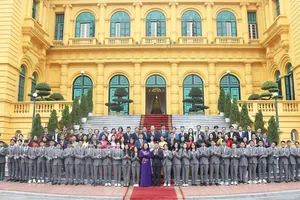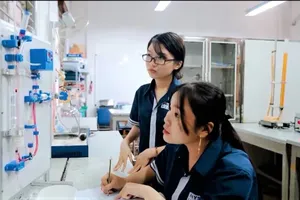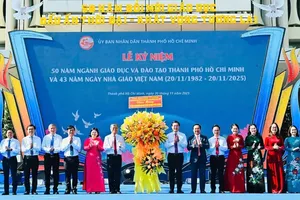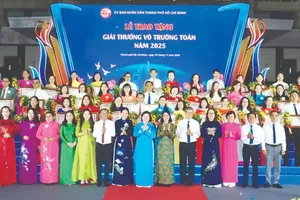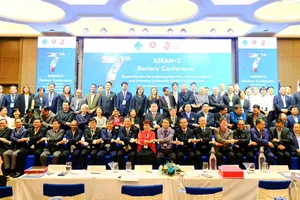
Since 2024, numerous schools have introduced enrollment programs in microchip technology (IC) and semiconductors to address the critical shortage of skilled professionals in this field in Vietnam.
However, experts emphasize that the immediate priority is to establish a comprehensive IC and semiconductor training program that meets international standards. This requires active collaboration with industry enterprises and increased investment from the Government to ensure a well-structured and globally competitive workforce development strategy.
Dozens of universities and colleges have lately announced enrollment information for IC and semiconductors in 2025. In the Southern region, three member schools of Ho Chi Minh City National University, namely University of Technology, University of Information Technology and University of Sciences, have approved the opening of IC and semiconductors. Ho Chi Minh City National University currently trains about 6,000 students in majors directly and indirectly related to IC and semiconductors.
VNU-HCM plans to offer in-depth training in microchip design from now until 2030, with the goal of recruiting and training approximately 1,000 specialists in microchip and semiconductor technology by 2027.
In the Northern region, Hanoi University of Science and Technology currently has 2 direct training majors and 7 related training majors in design, production, packaging and testing, supporting semiconductor chip applications with a total of more than 3,300 students. To meet the growing demand of the semiconductor industry, VNU-HCM member schools train 1,500 students yearly, with a target to double this number.
In addition to training engineers and bachelor's degree holders, schools will also offer specialized programs for students with related academic backgrounds, ranging from six months to one year. These programs aim to rapidly supplement the industry's workforce while also fostering the development of experts in innovation and invention.
To rapidly address industry workforce demands, institutions will provide accelerated training programs, ranging from six months to one year, for graduates of related disciplines, alongside traditional engineering and bachelor's degrees. This initiative also aims to cultivate experts in invention and innovation.
In the Central region, member institutions of Da Nang University—including University of Science and Technology, University of Technical Education, and Vietnam-Korea University of Information Technology and Communications—have officially commenced enrollment for the semiconductor design major.
In addition, many public and private universities have started enrolling students in the semiconductor design major this year, such as Ho Chi Minh City University of Industry, FPT University, Phenikaa University, Saigon International University, Hanoi University of Science and Technology, and Can Tho University.
According to Dr. Vo Xuan Hoai, Deputy Director of the National Innovation Center under the Ministry of Planning and Investment, only a handful of Vietnam's 300-plus universities and colleges offer semiconductor design training programs or have adapted existing majors to include such curriculum. These programs often lack adequate laboratory facilities, practical hands-on components, and industry partnerships.
Currently, Vietnam has about 5,000 engineers working in the field of microchip design, meeting only 20 percent of the demand, most concentrated in Ho Chi Minh City (85 percent), Hanoi (8 percent), and Da Nang (7 percent).
Compared to actual demand, this number is still very modest, especially in the context of Vietnam's microchip development strategy from now to 2030, which requires at least 50,000 high-quality human resources for this industry.
Professor Nguyen Thi Thanh Mai, Vice President of Ho Chi Minh City National University, emphasized that training human resources in microchip technology and semiconductors requires significant financial investment.
Recognizing the limitations of university-led comprehensive training, a multi-stakeholder collaborative approach is essential. Accordingly, the State should implement strategic investment policies regarding infrastructure and scholarship programs. Furthermore, industry engagement is crucial, encompassing the co-development of training curricula, active participation in instruction, targeted recruitment, scholarship provision, and the facilitation of student practicums and laboratory internships.
In addition to investment attraction policies, localities need to require investors to support and participate in the process of training human resources at schools.
Since 2022, Professor Koichiro Ishibashi, Director of the Ishibashi Laboratory at University of Electro-Communications of Japan, has been teaching specialized courses on microchip technology at University of Sciences and University of Technology (VNU-HCM). He noted that Vietnam currently lacks an official microchip technology training program, with only a small portion integrated into electrical and electronics curricula.
Additionally, he added the country has no enterprises dedicated to microchip technology development in the true sense. To build a skilled workforce in this field, he emphasized the need for a clear human resource strategy, financial support, and well-equipped facilities to develop training programs that meet international standards.


